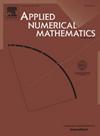Localization of tumor through a non-conventional numerical shape optimization technique
IF 2.4
2区 数学
Q1 MATHEMATICS, APPLIED
引用次数: 0
Abstract
This paper presents a method for estimating the shape and location of an embedded tumor using shape optimization techniques, specifically through the coupled complex boundary method. The inverse problem—characterized by a measured temperature profile and corresponding heat flux (e.g., from infrared thermography)—is reformulated as a complex boundary value problem with a complex Robin boundary condition, thereby simplifying its over-specified nature. The geometry of the tumor is identified by optimizing an objective functional that depends on the imaginary part of the solution throughout the domain. The shape derivative of the functional is derived through shape sensitivity analysis. An iterative algorithm is developed to numerically recover the tumor shape, based on the Riesz representative of the gradient and implemented using the finite element method. In addition, the mesh sensitivity of the finite element solution to the state problem is analyzed, and bounds are established for its variation with respect to mesh deformation and its gradient. Numerical examples are presented to validate the theoretical results and to demonstrate the accuracy and effectiveness of the proposed method.
利用非常规数值形状优化技术对肿瘤进行定位
本文提出了一种利用形状优化技术,特别是通过耦合复杂边界方法来估计嵌入肿瘤的形状和位置的方法。反问题——以测量的温度剖面和相应的热通量(例如,来自红外热成像)为特征——被重新表述为具有复杂Robin边界条件的复杂边值问题,从而简化了其过度指定的性质。通过优化目标函数来识别肿瘤的几何形状,目标函数依赖于整个域内解的虚部。通过形状灵敏度分析,导出了泛函的形状导数。提出了一种基于Riesz梯度表示的肿瘤形状数值恢复迭代算法,并采用有限元法实现。此外,分析了状态问题有限元解的网格灵敏度,并建立了其随网格变形及其梯度变化的边界。数值算例验证了理论结果,验证了所提方法的准确性和有效性。
本文章由计算机程序翻译,如有差异,请以英文原文为准。
求助全文
约1分钟内获得全文
求助全文
来源期刊

Applied Numerical Mathematics
数学-应用数学
CiteScore
5.60
自引率
7.10%
发文量
225
审稿时长
7.2 months
期刊介绍:
The purpose of the journal is to provide a forum for the publication of high quality research and tutorial papers in computational mathematics. In addition to the traditional issues and problems in numerical analysis, the journal also publishes papers describing relevant applications in such fields as physics, fluid dynamics, engineering and other branches of applied science with a computational mathematics component. The journal strives to be flexible in the type of papers it publishes and their format. Equally desirable are:
(i) Full papers, which should be complete and relatively self-contained original contributions with an introduction that can be understood by the broad computational mathematics community. Both rigorous and heuristic styles are acceptable. Of particular interest are papers about new areas of research, in which other than strictly mathematical arguments may be important in establishing a basis for further developments.
(ii) Tutorial review papers, covering some of the important issues in Numerical Mathematics, Scientific Computing and their Applications. The journal will occasionally publish contributions which are larger than the usual format for regular papers.
(iii) Short notes, which present specific new results and techniques in a brief communication.
 求助内容:
求助内容: 应助结果提醒方式:
应助结果提醒方式:


